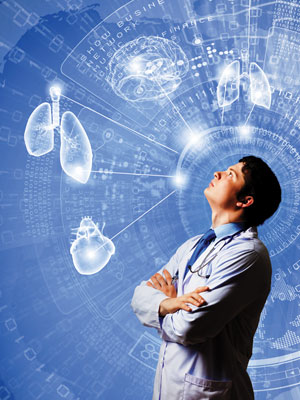
Information technology is a pivotal tool that has the potential to tilt the growth scenario in all verticals of life. Sectors like banking and telecom have leveraged IT and they are at an advanced stage of IT adoption. In healthcare, we have been talking about the dire need for transformation but so far the change has been slow.
 The viable and vibrant solution seems to have evaded healthcare IT so far. The IT segment in healthcare has yet to capture the full share of the limelight.
The viable and vibrant solution seems to have evaded healthcare IT so far. The IT segment in healthcare has yet to capture the full share of the limelight.
Healthcare IT is a cluster of alliances spread across organisations like healthcare providers, diagnostic industry, infrastructure companies, policy makers, health funders, software developers, healthcare insurance and even academic institutions. They need to work in tandem to emerge as winners.

In India, the medical technology sector was valued at USD 6.3 billion in 2013 at end consumer prices and is growing around 12 percent per year. This sector remains highly unexplored, rather under-penetrated; accounting for 8 percent of spending in healthcare vs 18 percent in pharmaceuticals.
Challenging demands
Besides lack of clarity (in terms of regulation) and market access, there are other impediments that impact the limited investment in the sector. This adversely tells on the basic healthcare ecosystem and the subsidiary technology skills to support the market.
26 percent of the hospitals are positioned in the seven metros that cater to only 7 percent of the Indian population. A large percentage of Indians in the remote areas have been left behind. They lag behind in access to healthcare, and medical technologies in particular. These include lack of screening, awareness, diagnosis, affordable technologies, etc.
The government has recognised these challenges and efforts (like Rashtriya Bima Yojna) have been made to consolidate the reachout. It is precisely here that the medical technology comes to the fore to extend their reach beyond the physical catchmentarea. We take a look (page 26) at the model initiated by World Health Partners (WHP) who made over 1, 20,000 telemedicine consultations in rural India. Using the latest advances in medical technology, WHP, with support from Bill & Melinda Gates Foundation, has established a cost effective network of health services in rural India.
Given the inequity in distribution of healthcare infrastructure, telemedicine can play a pivotal role. This leads the industry to provide medical devices to remotely use the video and audio applications. Today, we can compress a high definition (HD) video (720 P 30 fps ) into as little as 512 kbps. The current issue features the industries that are working hard to overcome the challenges of time and distance.
“Unlike banking and telecom sectors, which have leveraged Information Technology and are at an advanced stage of IT adoption, the healthcare sector is yet to repeat the feat”
CIOs
At one point of time, the CIO was a transient position but today its a vibrant profile. On one hand the CIO needs to think of business by leveraging technology and on the other they need to deliver high end patient care using the interoperable technology. Today, patients are exposed to multiple health conditions and this warrants multiple treatment locations. In general, IT needs to address this multiplesharing of health records amidst dizzying array of disparate systems. More precisely, the CIO needs to ponder over these given equations, besides the sweep of regulatory reforms, patient outreach, readmissions, image branding, etc.
Aspects of CIOs role in healthcare have been evolving and will continue to do so. Today, a good many hospitals have embraced IT and others are on the verge of integrating technology in various ways.
We talk to CIOs in healthcare across the nation, to assess their achievements, problems, solutions and the road ahead.
Be a part of Elets Collaborative Initiatives. Join Us for Upcoming Events and explore business opportunities. Like us on Facebook , connect with us on LinkedIn and follow us on Twitter , Instagram.












